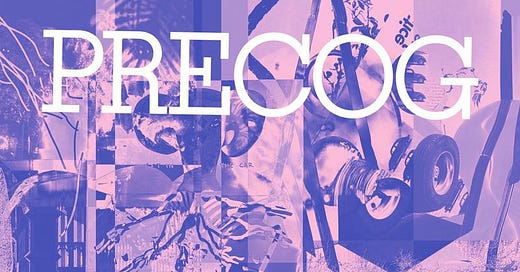I was thrilled when Florencia Escudero and Gaby Collins-Fernandez asked me to submit an essay to Precog; it’s become one of my favorite independent, artist-run publications. For today’s newsletter, I wanted to share an excerpt from my article for Precog. It’s about the promises and pitfalls of QR codes in museums and galleries. You can find it in Precog 8: Bad Interface, along with a bunch of fascinating articles and artist projects. There’s articles on how it used to be cool to take transatlantic voyages during storms, a poetic take on indegeneity and AI, and, because nobody is too post-irony, an essay on falling in love and staying that way in a teeny-tiny room.
Also, how can I influence museum policy on QR code use?
Who Is “Able” to Scan the White Cube?: QR Codes, Disability, and Museums [Excerpt]
Attending to the current use of QR codes in museums prior to any widespread adoption as replacement media means there’s time to help shape policy debates over how they can better address a wide range of museum visitors and their own, specialized desires and needs—if QR codes are necessary at all. Given that museums rarely have ways for visitors to seek out information from a human volunteer in a gallery, relying entirely on QR codes for information contributes to conceptions of museums as inscrutable or indifferent to considerations of class, disability, and neurodiversity . . . .
The conflicts between intended and actual behaviors with QR codes concern a range of users. There are economic limitations regarding cellphone data plan use if the museum or gallery does not provide free wi-fi services. There are age limitations as well for visitors both young and old: toddlers and children do not always have smartphones out and ready to use independently, for a variety of reasons related to both physiognomy and parenting decisions, while elderly persons with arthritis, circulation issues, or other forms of reduced dexterity may be unable to reliably carry a smartphone with them and raise their phone to a QR code. Similarly, parents visiting museums with babies or toddlers (or both at one time) often wrestle with a constant series of hands-based activities, from fetching snacks to adjusting straps, disrupting any smooth application of scanning a QR code at every single artwork in an exhibition. Finally, at the level of preference, some people may simply prefer flip phones for reasons of privacy; some people may simply desire to not use their phone at all when in an art gallery without being reminded of push updates, iMessages, or Slack notifications. These conflicts point to the social privileges of those who can easily access QR codes to the disadvantage of more diverse audiences who may not always want, desire, or have access to online, hand-based mobile technology during the entirety of their museum visit.
Some of these conflicts relate more specifically to physical and cognitive disabilities.[1] For instance, the assumption that visitors have easy access to hand-based mobile technology during the entirety of their museum visit presumes that users have neither arthritis nor anxiety. Other visitors might be preoccupied with an animal’s lead, e.g., when needed for a service animal, or with a walking cane. As a counterpoint, there is some evidence that QR codes are helpful for blind to low-vision users in galleries. But in order for the codes to be helpful in practice, recommendations include needing to make QR codes that are large enough to be seen at a distance by low-vision users, or “having the QR code on a label which the visitor could move” due to how some visitors have “physical difficulties of aligning the camera.”[2] In other words, most QR codes that one sees in public spaces bring up accessibility concerns as they are currently inaccessible to some degree.
[1] In the United States, where I am writing this essay, the Americans with Disability Act (ADA) considers a disability as that which “substantially limits one or more major life activities” and includes both physical and cognitive disabilities ranging from diabetes to ADHD. See: “Introduction to the Americans with Disabilities Act,” ADA.gov, accessed May 17, 2023, https://www.ada.gov/topics/intro-to-ada/.
[2] Annette Haworth and Peter Williams, “Using QR Codes to Aid Accessibility in a Museum,” Journal of Assistive Technologies 6, no. 4 (November 2012): 286–7, https://doi.org/10.1108/17549451211285771.



